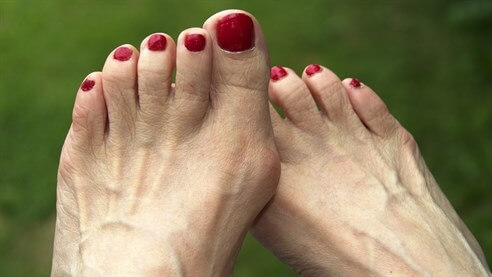Bunions - New NICE Guidelines
NICE guidelines now recommend referral to a Podiatric Surgeon to treat painful bunions.
Private
To book a private consultation with Mrs D Nicholl FCPodS, Consultant podiatric surgeon at Fitter Feet for Life, first ask your GP to provide a referral, which should be sent by email to info@fitterfeet.co.uk, with a summary medical history. Private health insurers require such a referral before authorising payment for your consultation and private surgery.
NHS
You can also see Mrs Nicholl as an NHS patient. Ask your GP to make a referral to Mrs D Nicholl FCPodS Consultant podiatric surgeon at Guys and St Thomas NHS trust. Your GP should email the referral to gst-trpodiatricsurgery@nhs.net with a summary medical history.

What are bunions
A bunion, also known as ‘hallux valgus’, is a deformity of the big toe in which the big toe excessively angles towards the second toe and leads to a bony lump on the side of the foot. This can also form a large sac of fluid, known as a bursa, which can then become inflamed and sore.
What causes them?
They are most often caused by a defective mechanical structure of the foot, which is genetic, and which makes a person prone to developing a bunion. Poorly fitting footwear tends to aggravate the problem as tight or narrow footwear can squeeze the forefoot, crowding the toes together and exacerbate the underlying condition, causing pain and deformity of the joint.
Bunions can also be caused by the big toe pushing over on to the second, causing crossover of the toes, which makes it difficult to walk due to pressure on the toes from footwear. Once the big toe leans toward the second toe, the tendons no longer pull the toe in a straight line, so the problem tends to get progressively worse. This condition can also lead to corns and calluses developing.
Bunions can also be caused by age, arthritis or playing sport.
Are they serious?
Some people have large bunions that cause no pain but do cause difficulties with footwear, while others have relatively small bunions that can be very painful. Although some treatments can ease the pain of bunions, only surgery can correct the defect.
In some cases, pressure from the big toe joint can lead to a deformity in the joint of the second toe, pushing it toward the third toe and so on.
Some bunions will lead to bursas, but having a bunion doesn’t mean necessarily that you will develop a bursa.
How are bunions treated?
Your podiatrist may recommend the following non-surgical treatments
• Exercises
• Orthoses (special devices inserted into shoes)
• Shoe alterations or night splints which hold toes straight during sleep (helps to slow the progression of bunions in children)
These are all conservative measures and, although they may help relieve painful symptoms, they don’t correct the underlying deformity.
Mrs Nicholl is a consultant podiatric surgeon. If you are referred to her she will evaluate the extent of the deformity. She can remove the bunion by realigning the 1st metatarsal and the toe. There are more than 130 different types of operation that fall under this title, so each individual surgery is different. Each bunion deformity is evaluated and the best solution is chosen for each individual.
The aim of surgery is to address the underlying deformity to prevent recurrence. As with all surgery, there are risks and complications, so it is not usually advised unless your bunions are causing pain – or are starting to deform your other toes.
How can I prevent bunions?
Wearing sensible shoes that fit well is a good preventative measure. If you notice a bump developing where your big toe joins the foot, it may be time to switch your footwear. Try to opt for wider shoes that provide your toes with room to move and keep your heel height to no more than 4cm for maximum comfort. The following also serves as a useful guide:
• Wear backless, high-heeled shoes in moderation. Backless shoes force your toes to claw as you walk, straining the muscles if worn over a long period.
• Vary your heel heights from day to day, one day wearing low heels and the next day slightly higher heels.
• If you want to wear a heel every day, keep heel heights to 4cm or less.
• Wearing a shoe with a strap or lace over the instep holds the foot secure and helps stop your foot sliding forward.
• Calf stretches to counteract the shortening of the calf can help to keep feet supple.
Here is a link Here is a link to the NICE guidelines about bunions.



